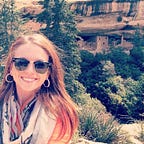Photogrammetry: From Light Tent to 3D Model
Despite how easy photogrammetry may appear to be, there are certain elements of the process that must be carefully considered before being able to create a clear and useable model. For our next project, our task was to choose a small object for close-range photogrammetry. I chose a plastic plant in a cream ceramic pot. I chose this object based on the dynamic position of the plastic leaves, and thought it would result in a great 3D printed object. When setting up the light tent with a green screen background, it did occur to me that the coloration of the plastic plant may not be accurately detected by the software, as the two greens were very similar in color. To resolve this issue, I choose to use the plain white background of the light tent and began the photogrammetry process. During this session of shooting the photos, we had two cameras set atop each other and positioned at two different angles.
This saved me time in capturing the images, as it allowed me to only take one set of photos that registered at two different angles for each rotation of the object. After uploading the photos into PhotoScan, I began running the sparse cloud, and could immediately tell something went wrong. While I did account for the issues with the green background, it did not occur to me that the back of the white light tent had a long zipper that the software could detect was stationary. Photogrammetry in a light tent works by manipulating the object on a moveable platform that allows you to trick the software into thinking you are making a physical rotation around the object, and since the zipper was in the same location in all of the photos this completely through off the model’s detection of the points. Despite attempting to mask the background, the best method to produce a quality model was to reshoot the photos using a black background instead. For this shoot I did not have the ability to use both cameras positioned at the different angles at the same time, however I found this preferable in that it allowed me to have the ability to choose the individual angles with more precision. Once the photos were reshot, I attempted to run the sparse cloud with no avail as the photos still needed masking to complete the model. Once the photos were masked, they provided a much cleaner model, which unlike the first two attempts, actually looked like the potted plant. The model did end up with a few holes in the side of the pot, which could have possibly been caused by the strong glare coming of the shiny base.
This assignment in using a light booth for photogrammetry taught me two valuable lessons. The first, is that you must be mindful of how the model will turn out based on the object you choose to use. In the case of the potted plant it was crucial to understand how the green leaves would read in the software using the green screen background, how the shine of the base might refract light, and again how important it was to mask the black background. Conceptualizing what could go wrong before starting the process is helpful for any attempt of photogrammetry. The second major lesson I learned from using the lighting booth was how important it is when using the light booth, to ensure that you have a smooth background that does not have any type of feature that the software could mistake for parts to be included in the model. In this model, using a background with a stationary zipper caused all of the photos to try to align themselves in relation to the zipper rather that the object. Photogrammetry is a great technique that aids in creating 3D models but just like any other technique, photogrammetry takes invested time to fully understand the tricks of the trade.
